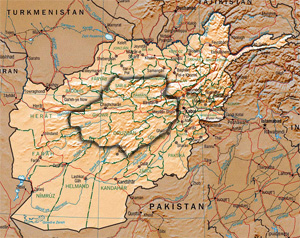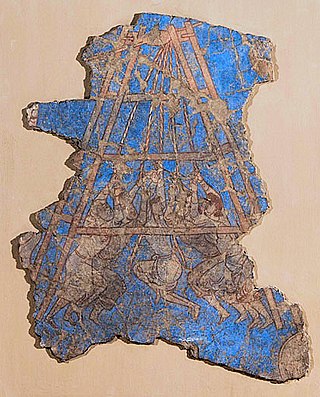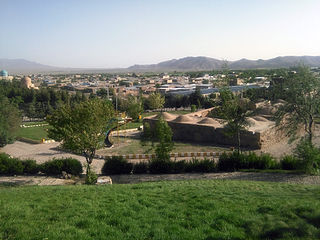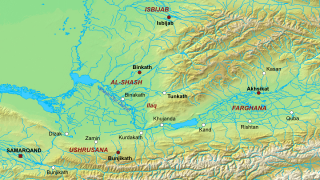Related Research Articles

Bactria, or Bactriana, was an ancient Iranian civilization in Central Asia based in the area south of the Oxus River and north of the mountains of the Hindu Kush, an area within the north of modern Afghanistan. Bactria was strategically located south of Sogdia and the western part of the Pamir Mountains. The extensive mountain ranges acted as protective "walls" on three sides, with the Pamir on the north and the Hindu Kush on south forming a junction with the Karakoram range towards the east.

Hazarajat, also known as Hazaristan is a mostly mountainous region in the central highlands of Afghanistan, among the Kuh-e Baba mountains in the western extremities of the Hindu Kush. It is the homeland of the Hazara people who make up the majority of its population. Hazarajat denotes an ethnic and religious zone.

Bilad al-Sham, often referred to as Islamic Syria or simply Syria in English-language sources, was a province of the Rashidun, Umayyad, Abbasid, and Fatimid caliphates. It roughly corresponded with the Byzantine Diocese of the East, conquered by the Muslims in 634–647. Under the Umayyads (661–750) Bilad al-Sham was the metropolitan province of the Caliphate and different localities throughout the province served as the seats of the Umayyad caliphs and princes.

Greater Khorāsān or Khorāsān or Khurāsān is a historical eastern region in the Iranian Plateau between West and Central Asia that encompasses western Afghanistan, northeastern Iran, the eastern halves of Turkmenistan and Uzbekistan, western Tajikistan, and portions of Kyrgyzstan and Kazakhstan.

Jibāl, also al-Jabal, was the name given by the Arabs to a region and province located in western Iran, under the Umayyad and Abbasid Caliphates.

Chaghaniyan, known as al-Saghaniyan in Arabic sources, was a medieval region and principality located on the right bank of the Oxus River, to the south of Samarkand.
Hulwan was an ancient town on the Zagros Mountains in western Iran, located on the entrance of the Paytak Pass, nowadays identified with the town of Sarpol-e Zahab.
Abū Ḥafṣ Qutayba ibn Abī Ṣāliḥ Muslim ibn ʿAmr al-Bāhilī was an Arab commander of the Umayyad Caliphate who became governor of Khurasan and distinguished himself in the conquest of Transoxiana during the reign of al-Walid I (705–715). A capable soldier and administrator, he consolidated Muslim rule in the area and expanded the Caliphate's border to include most of Transoxiana. From 705 to c. 710, he consolidated Muslim control over the native principalities of Tokharistan and conquered the principality of Bukhara, while in 710–712 he conquered Khwarizm and completed the conquest of Sogdiana with the capture of Samarkand. The latter opened the road to the Jaxartes valley, and during the last years of his life Qutayba led annual campaigns there, extending Muslim control up to the Fergana Valley and parts of Chinese Turkestan.
The NahrawanCanal was a major irrigation system of the Sasanian and early Islamic periods in central Iraq, along the eastern banks of the Tigris and the lower course of the Diyala River. Created in the 6th century, it reached its peak under the Abbasid Caliphate, when it served the main water supply for the Abbasid capital of Baghdad, while the regions irrigated by it served as the city's main breadbasket. Its destruction and progressive abandonment from the mid-10th century onwards mirror the Abbasid Caliphate's decline.

The Khulm River is a river of north-central Afghanistan. In its lower course, it passes through Khulm and Haybak in Balkh Province. The Khulm is a tributary to the Oxus basin. Its source is south of the city of Khulm and it passes through the city of Samangan and Samangan Province. The Khulm River forms the western border of Kunduz Province.

The Muslim conquest of Transoxiana or Arab conquest of Transoxiana were the 7th and 8th century conquests, by Umayyad and Abbasid Arabs, of Transoxiana, the land between the Oxus and Jaxartes rivers, a part of Central Asia that today includes all or parts of Uzbekistan, Tajikistan, Kazakhstan, and Kyrgyzstan.

Kuhbanan is a city in the Central District of Kuhbanan County, Kerman province, Iran, serving as capital of both the county and the district.

Transoxiana or Transoxania is the Latin name for the region and civilization located in lower Central Asia roughly corresponding to modern-day eastern Uzbekistan, western Tajikistan, parts of southern Kazakhstan, parts of Turkmenistan and southern Kyrgyzstan. The name was first coined by Alexander the Great in the 4th century BC when Alexander's troops were able to conquer the region. The region may have had a similar Greek name in the days of Alexander the Great, but the earlier Greek name is no longer known. Geographically, it is the region between the rivers Amu Darya to its south and the Syr Darya to its north.
Khuttal, frequently also in the plural form Khuttalan was a medieval region and principality on the north bank of the river Oxus, lying between its tributaries Vakhsh and Panj. It corresponds roughly to the modern Khatlon Province of Tajikistan.
Maryamin is a village in central Syria, administratively part of the Homs Governorate starting from 2008 after being part of the Hama Governorate, located in Homs Gap southwest of Hama. Nearby localities include Aqrab, Nisaf and Baarin to the north, Kafr Kamrah and Mashta al-Helu to the west, Shin, al-Shinyah and al-Qabu to the south, and Taldou and Tell Dahab to the east. According to the Syria Central Bureau of Statistics, Maryamin had a population of 4,174 in the 2004 census. Its inhabitants are predominantly Alawites.

Qubodiyon, also Qubadiyan, ancient Kobadiyan is a town in the Khatlon Region of Tajikistan. It is the capital of Qubodiyon District. The population of the town is 12,200.
The (Great) Khurasan Road was the great trunk road connecting Mesopotamia to the Iranian Plateau and thence to Central Asia, China, and the Indus Valley.

Ilaq was a medieval region in Transoxiana which was located in modern northeastern Uzbekistan, to the east of the Syr Darya and south of Tashkent. The capital of the district was Tunkath.
The Nahr Isa or Isa Canal was a navigable canal that linked the two great rivers of Mesopotamia, the Euphrates and the Tigris, during the Abbasid Caliphate. It was one of the main water sources and the main avenue of river-borne commerce for the Abbasid capital of Baghdad.
Tawwaj, Tawwaz or Tavvaz was a medieval city in Fars (Pars) in modern Iran, located southwest of Shiraz.
References
- ↑ Bosworth 1986, pp. 286–287.
- 1 2 3 4 5 6 7 Bosworth 1986, p. 287.
- 1 2 Le Strange 1905, p. 439.
- ↑ Le Strange 1905, pp. 439–440.
- ↑ Le Strange 1905, p. 440.